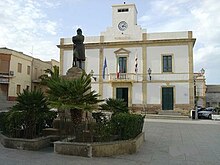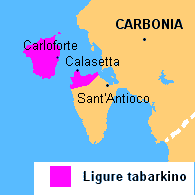Calasetta
| Calasetta | ||
|---|---|---|

|
|
|
| Country | Italy | |
| region | Sardinia | |
| province | South Sardegna (SU) | |
| Local name | Câdesédda (Tabarchino) Cal '' e Sèda (Sardinian) |
|
| Coordinates | 39 ° 7 ' N , 8 ° 22' E | |
| surface | 31 km² | |
| Residents | 2,847 (Dec 31, 2019) | |
| Population density | 92 inhabitants / km² | |
| Post Code | 09011 | |
| prefix | 0781 | |
| ISTAT number | 111008 | |
| Popular name | Calasettani | |
| Patron saint | San Maurizio | |
| Website | Calasetta | |
 Calasetta |
||
Calasetta (in Tabarkine Ligurian Câdesédda , in Sardinian Cal '' e Sèda ) is an Italian commune in the province of Sud Sardegna in the autonomous region of Sardinia . The community has 2847 inhabitants (as of December 31, 2019).
geography
Calasetta is located in the southwest of Sardinia on the island of Sant'Antioco . The municipality covers the north-western third of the island, which is otherwise administered by the neighboring municipality of Sant'Antioco . The gentle hills is by Mediterranean Macchiavegetation coined. In the northeast, the municipality begins at the foothills of the Sa Scrocca mountain, which is visible from afar with its antenna masts, behind the town of Cussorgia ( Cristo Ré ). From there a bay stretches in a wide arc to the west, at the end of which is the port of Calasetta at the tip of a headland. In the south-west of the village there are three bays, the beaches of which are among the most famous tourist attractions of the municipality. The beaches are called Sotto Torre , La Salina and Spiaggia Grande , sometimes they are simply numbered in this order (1st to 3rd beach). Behind the Spiaggia Grande , a steep cliff follows in a southerly direction , on which a first deeper indentation with a small beach opens up at Cala Lunga . The coastal section of the municipality of Calasetta also ends here. The slightly larger bay of "Cala Sapone" ( Cal'e Saboni ) that follows immediately afterwards already belongs to the municipality of Sant'Antioco. The population is concentrated in Calasetta, in Cussorgia and on the beaches mentioned. The hinterland in the north of the municipality is still dominated by agriculture (mainly viticulture ), in the south it is almost deserted.
The island of Sant'Antioco, together with the neighboring island of San Pietro and a few smaller islands, forms the Sulcis archipelago , which in turn forms the Sulcis landscape with the opposite coastal areas of the main island of Sardinia . Calasetta and its neighboring towns such as Carloforte and Sant'Antioco all have well-protected harbors.
History and language
Like the neighboring town of Carloforte, Calasetta has a special history that connects both places with Liguria and Tunisia even more than with Sardinia . In 1542 some families from Pegli near Genoa settled on the island of Tabarka , which is now in Tunisia, not far from the border with Algeria . The Lomellini family, a noble Genoese family, was granted a fishing and trading license there. The immigrants mainly devoted themselves to coral diving on Tabarka . They soon gained prosperity and reputation through trade, but then had to fend off more and more aggressive competitors and pirates . Finally, the coral yield also decreased.
In 1720 Sardinia came to the House of Savoy in Turin , whose continental possessions together with the island formed the Kingdom of Sardinia . King Charles Emanuel III. offered the Tabarkiners willing to emigrate to colonize the island of San Pietro in southwestern Sardinia, which they accepted in 1738. In 1741 the Bey of Tunis occupied the island of Tabarka and enslaved the inhabitants who remained there. Charles Emanuel III. achieved the release of many of these slaves, who were also settled on San Pietro, where the main town was named in honor of King Carloforte ("Charles the Strong"). Others were settled by Spain on the island of Nueva Tabarca near Alicante . Some families who had remained in Tunisia in relative freedom were allowed to settle on the uninhabited northwestern part of the island of Sant'Antioco in 1770. Here the Savoy had built a fortress-like watchtower ( Torre di Cala di Seta ) on a hill from 1756 to 1757 , which was supposed to help ward off North African pirates. At this watchtower, across from Carloforte, the newcomers founded the town of Calasetta. The site was laid out in a checkerboard pattern by the Piedmontese military engineer and mining scientist Pietro Belly . In the first few years there were still settlers from Piedmont , who soon left the place because of the difficult living conditions. Knights of the Mauritius Order earned services to the needy population in Calasetta . Between 1837 and 1839 the parish church of San Maurizio was built for the then almost 500 souls of the community . A renovation and expansion followed in 1956. In the church there is a work of art by the German painter Jörg Schreyögg .
While the people of Carloforte were mainly devoted to seafaring and fishing, Calasetta remained more of an agricultural area. This had certain consequences, especially in terms of language and culture. In Carloforte people stayed in contact with their Ligurian homeland through seafaring than in Calasetta, which is why the Tabarchino stayed closer to the development of the Ligurian language than that of Calasetta. In the rather rural-conservative Calasetta, on the one hand, more archaic forms of Ligurian were preserved, on the other hand, despite the mutual demarcation between Sardinians and Tabarkiners on the island of Sant'Antioco, the influences of the Sardinian language on the Tabarkini Calasettas were inevitable. In addition, loanwords from Arabic have been preserved in both Calasetta and Carloforte . Around two thirds of the inhabitants of Calasetta are still able to speak Tabarkini today. The Tabarkin dialect and culture is now under the special protection of the autonomous region of Sardinia and is taught in schools in the two municipalities of Calasetta and Carloforte.
economy
The people in Calasetta are mainly active in the service sector. During the summer, tourism is of great importance. There are smaller hotels on site , holiday homes are rented out, and there is a few agrotourism . There is a campsite on La Salina beach . In Calasetta, the watchtower serves as a cultural center, and there is a small museum for contemporary art next door .
Agriculture and fishing ( tuna ) only play a subordinate role.
armed forces
For a long time , the German Air Force maintained a camp on the Spiaggia Grande . It was a support facility of the Tactical Training Command of the Air Force in Italy , which until 2016 was based at the Decimomannu military airfield . Every now and then soldiers of the army and the navy of the Bundeswehr who practiced in Sardinia used the camp . As a rule, the German training command organized a festival every summer on the Piazza Belly , the central square in front of the Calasettas town hall, at which music bands that had come from Germany also performed.
traffic
The island of Sant'Antioco is connected to the main island of Sardinia in the northeast by a bridge and an isthmus . From Calasetta, the SS 126 state road leads to the neighboring municipality of Sant'Antioco and on to the provincial capitals Carbonia and Iglesias . From there there are train connections to Cagliari , the capital of Sardinia, which is around 100 km east of Calasetta. From Carbonia and Iglesias, Cagliari can also be reached on motorway-like roads . From 1926 to 1974 Calasetta had a train station . There was a narrow-gauge railway with connections to Carbonia and via Narcao to Siliqua to the Decimomannu – Iglesias railway line . The narrow-gauge railway ran from the port of Calasettas to Cussorgia and along the north coast to Sant'Antioco and from there to Carbonia or Siliqua. Buses have been running on the narrow-gauge lines since rail traffic was discontinued.
The port of Calasetta is divided into two areas. In the west is the yacht and fishing port . It is often the target of deep-sea fishermen from the Sicilian Mazara del Vallo . In the east is the ferry port , from where there are several daily ferry connections to Carloforte. Before entering Calasettas to the east, a bypass road branches off , which leads along the coast directly to the port.
Partnerships
Calasetta has partnerships with the municipalities of Pegli and Arenzano in Liguria. In addition, the municipality has been an honorary member of the metropolitan city of Genoa since 2006 .
Personalities
- Pietro Belly († 1791 in Turin), military engineer and mining scientist, created Calasetta
- Piero Biggio (1937–2007), papal diplomat
- Ermanno Leinardi (1933–2006), painter, most recently in Calasetta
- Bruno Rombi (* 1931), writer from Calasetta
Web links
- Official website (Italian)
- Pictures of Calasetta with description (PDF, English / Italian; 4.96 MB)
- About the watchtower of Calasetta (PDF, Italian; 122 kB)
- Museum of Contemporary Art in Calasetta (PDF, Italian; 45 kB)
- About the German Air Force in Calasetta
Individual evidence
- ↑ Statistiche demografiche ISTAT. Monthly population statistics of the Istituto Nazionale di Statistica , as of December 31 of 2019.





